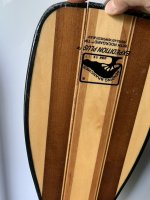Al, I assumed the creek was low from your comment that kayakers were lining some rapids. But the level doesn't matter for this principle to apply: When a whitewater river is so narrow that you can't even do an eddy turn, bad things will almost always happen if your canoe gets sideways.
If you can do a draw, cross-draw and a drawing sideslip, that's a really good start on whitewater technique, and all you probably need is more practice . . . = . . . more mistakes and slowly more success. More experience is also the only way to develop instinctive judgment as to how fast things will happen, and how much boat velocity (speed + direction) is needed to get from here to there, or to avoid THAT, given different bed gradients, current volumes and current velocities.
As to cross-draw vs. serial pries to move a canoe laterally to the off-side in whitewater: Traditional wisdom is that a cross-draw is a little dangerous because, for the moment your paddle is in the air, you will have no lever in the water to brace or accelerate if that's the moment when some soft or hard river thing decides to bash and unbalance you. On the other hand, serial pries can be a little dangerous because they are more likely to stick and jam the paddle into bed rocks in shallow waters.
I've always been primarily a cross-draw guy, but am awe of Bill Mason, who rarely used the cross-draw and could move laterally off-side with repeated gunwale pries even in big water, and could do so ambidextrously. At the end of Waterwalker, he solo paddles rapids for 11 minutes in canoes as big as MR Explorer, a collage of his 16' Chestnut Pal and Prospector, and does so from behind the ideal CLR.
Note how, at 1:09:40 (slightly after where the video below will start), Mason laterally moves his canoe off-side to the river right slot using only serial gunwale pries. Throughout the next 11 minutes of rapids, he moves laterally on-side with hanging draw sideslips and sculling draws, and moves laterally off-side almost always with brilliant pries. He clearly does not like to take his paddle out of the water unless he is turning with a cross-draw/Duffek or needs one powerful cross-bow yank. I've never seen anyone pry as well as him in whitewater, even paddlers I've known who were all-around better in more modern canoes.
I'll start another thread in the Paddling Techniques forum to pontificate on how the CLR relates directly to drawing and prying sideslip theory. Bring vodka.
If you can do a draw, cross-draw and a drawing sideslip, that's a really good start on whitewater technique, and all you probably need is more practice . . . = . . . more mistakes and slowly more success. More experience is also the only way to develop instinctive judgment as to how fast things will happen, and how much boat velocity (speed + direction) is needed to get from here to there, or to avoid THAT, given different bed gradients, current volumes and current velocities.
As to cross-draw vs. serial pries to move a canoe laterally to the off-side in whitewater: Traditional wisdom is that a cross-draw is a little dangerous because, for the moment your paddle is in the air, you will have no lever in the water to brace or accelerate if that's the moment when some soft or hard river thing decides to bash and unbalance you. On the other hand, serial pries can be a little dangerous because they are more likely to stick and jam the paddle into bed rocks in shallow waters.
I've always been primarily a cross-draw guy, but am awe of Bill Mason, who rarely used the cross-draw and could move laterally off-side with repeated gunwale pries even in big water, and could do so ambidextrously. At the end of Waterwalker, he solo paddles rapids for 11 minutes in canoes as big as MR Explorer, a collage of his 16' Chestnut Pal and Prospector, and does so from behind the ideal CLR.
Note how, at 1:09:40 (slightly after where the video below will start), Mason laterally moves his canoe off-side to the river right slot using only serial gunwale pries. Throughout the next 11 minutes of rapids, he moves laterally on-side with hanging draw sideslips and sculling draws, and moves laterally off-side almost always with brilliant pries. He clearly does not like to take his paddle out of the water unless he is turning with a cross-draw/Duffek or needs one powerful cross-bow yank. I've never seen anyone pry as well as him in whitewater, even paddlers I've known who were all-around better in more modern canoes.
I'll start another thread in the Paddling Techniques forum to pontificate on how the CLR relates directly to drawing and prying sideslip theory. Bring vodka.


